2001 CHRYSLER VOYAGER air condition
[x] Cancel search: air conditionPage 1334 of 4284
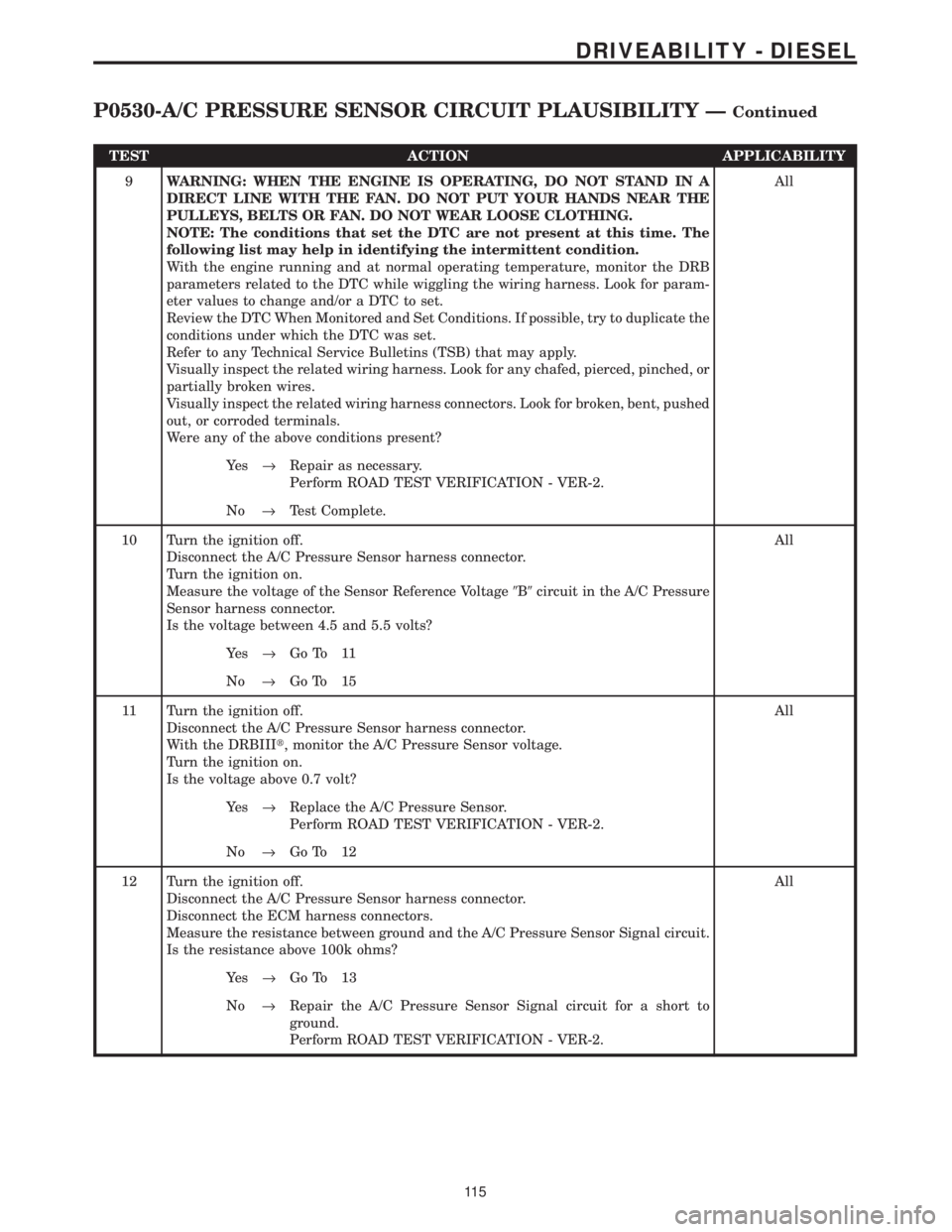
TEST ACTION APPLICABILITY
9WARNING: WHEN THE ENGINE IS OPERATING, DO NOT STAND IN A
DIRECT LINE WITH THE FAN. DO NOT PUT YOUR HANDS NEAR THE
PULLEYS, BELTS OR FAN. DO NOT WEAR LOOSE CLOTHING.
NOTE: The conditions that set the DTC are not present at this time. The
following list may help in identifying the intermittent condition.
With the engine running and at normal operating temperature, monitor the DRB
parameters related to the DTC while wiggling the wiring harness. Look for param-
eter values to change and/or a DTC to set.
Review the DTC When Monitored and Set Conditions. If possible, try to duplicate the
conditions under which the DTC was set.
Refer to any Technical Service Bulletins (TSB) that may apply.
Visually inspect the related wiring harness. Look for any chafed, pierced, pinched, or
partially broken wires.
Visually inspect the related wiring harness connectors. Look for broken, bent, pushed
out, or corroded terminals.
Were any of the above conditions present?All
Ye s®Repair as necessary.
Perform ROAD TEST VERIFICATION - VER-2.
No®Test Complete.
10 Turn the ignition off.
Disconnect the A/C Pressure Sensor harness connector.
Turn the ignition on.
Measure the voltage of the Sensor Reference Voltage9B9circuit in the A/C Pressure
Sensor harness connector.
Is the voltage between 4.5 and 5.5 volts?All
Ye s®Go To 11
No®Go To 15
11 Turn the ignition off.
Disconnect the A/C Pressure Sensor harness connector.
With the DRBIIIt, monitor the A/C Pressure Sensor voltage.
Turn the ignition on.
Is the voltage above 0.7 volt?All
Ye s®Replace the A/C Pressure Sensor.
Perform ROAD TEST VERIFICATION - VER-2.
No®Go To 12
12 Turn the ignition off.
Disconnect the A/C Pressure Sensor harness connector.
Disconnect the ECM harness connectors.
Measure the resistance between ground and the A/C Pressure Sensor Signal circuit.
Is the resistance above 100k ohms?All
Ye s®Go To 13
No®Repair the A/C Pressure Sensor Signal circuit for a short to
ground.
Perform ROAD TEST VERIFICATION - VER-2.
11 5
DRIVEABILITY - DIESEL
P0530-A/C PRESSURE SENSOR CIRCUIT PLAUSIBILITY ÐContinued
Page 1337 of 4284
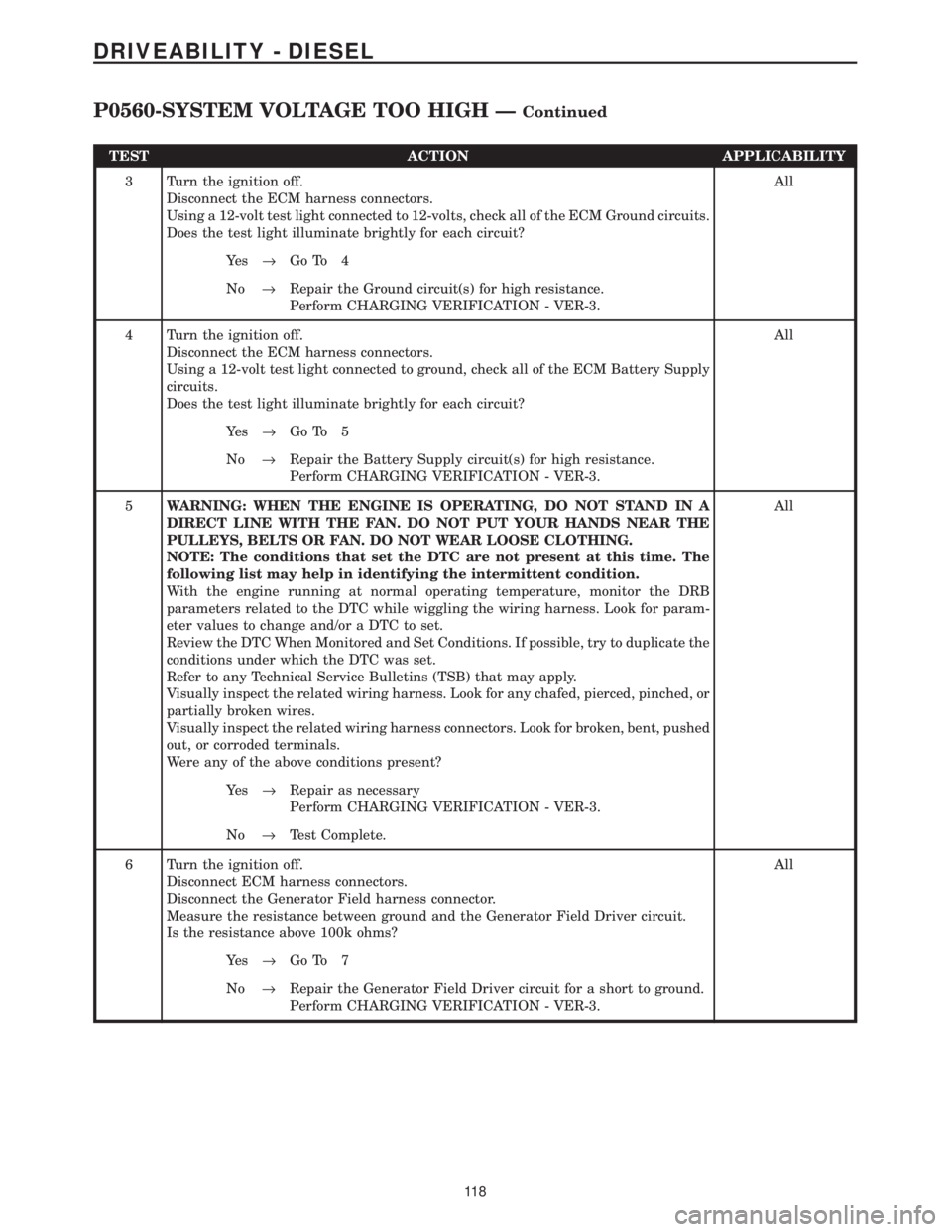
TEST ACTION APPLICABILITY
3 Turn the ignition off.
Disconnect the ECM harness connectors.
Using a 12-volt test light connected to 12-volts, check all of the ECM Ground circuits.
Does the test light illuminate brightly for each circuit?All
Ye s®Go To 4
No®Repair the Ground circuit(s) for high resistance.
Perform CHARGING VERIFICATION - VER-3.
4 Turn the ignition off.
Disconnect the ECM harness connectors.
Using a 12-volt test light connected to ground, check all of the ECM Battery Supply
circuits.
Does the test light illuminate brightly for each circuit?All
Ye s®Go To 5
No®Repair the Battery Supply circuit(s) for high resistance.
Perform CHARGING VERIFICATION - VER-3.
5WARNING: WHEN THE ENGINE IS OPERATING, DO NOT STAND IN A
DIRECT LINE WITH THE FAN. DO NOT PUT YOUR HANDS NEAR THE
PULLEYS, BELTS OR FAN. DO NOT WEAR LOOSE CLOTHING.
NOTE: The conditions that set the DTC are not present at this time. The
following list may help in identifying the intermittent condition.
With the engine running at normal operating temperature, monitor the DRB
parameters related to the DTC while wiggling the wiring harness. Look for param-
eter values to change and/or a DTC to set.
Review the DTC When Monitored and Set Conditions. If possible, try to duplicate the
conditions under which the DTC was set.
Refer to any Technical Service Bulletins (TSB) that may apply.
Visually inspect the related wiring harness. Look for any chafed, pierced, pinched, or
partially broken wires.
Visually inspect the related wiring harness connectors. Look for broken, bent, pushed
out, or corroded terminals.
Were any of the above conditions present?All
Ye s®Repair as necessary
Perform CHARGING VERIFICATION - VER-3.
No®Test Complete.
6 Turn the ignition off.
Disconnect ECM harness connectors.
Disconnect the Generator Field harness connector.
Measure the resistance between ground and the Generator Field Driver circuit.
Is the resistance above 100k ohms?All
Ye s®Go To 7
No®Repair the Generator Field Driver circuit for a short to ground.
Perform CHARGING VERIFICATION - VER-3.
11 8
DRIVEABILITY - DIESEL
P0560-SYSTEM VOLTAGE TOO HIGH ÐContinued
Page 1339 of 4284
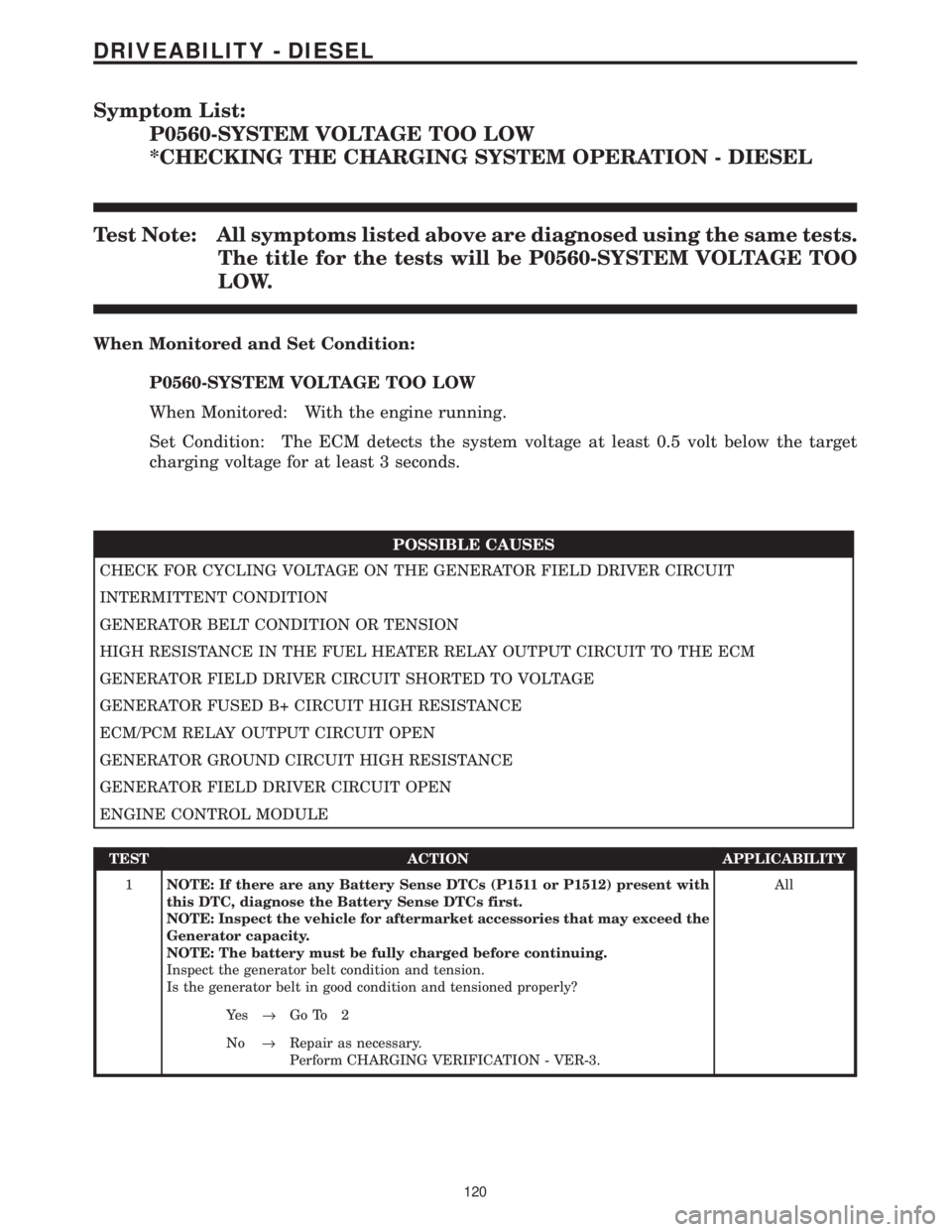
Symptom List:
P0560-SYSTEM VOLTAGE TOO LOW
*CHECKING THE CHARGING SYSTEM OPERATION - DIESEL
Test Note: All symptoms listed above are diagnosed using the same tests.
The title for the tests will be P0560-SYSTEM VOLTAGE TOO
LOW.
When Monitored and Set Condition:
P0560-SYSTEM VOLTAGE TOO LOW
When Monitored: With the engine running.
Set Condition: The ECM detects the system voltage at least 0.5 volt below the target
charging voltage for at least 3 seconds.
POSSIBLE CAUSES
CHECK FOR CYCLING VOLTAGE ON THE GENERATOR FIELD DRIVER CIRCUIT
INTERMITTENT CONDITION
GENERATOR BELT CONDITION OR TENSION
HIGH RESISTANCE IN THE FUEL HEATER RELAY OUTPUT CIRCUIT TO THE ECM
GENERATOR FIELD DRIVER CIRCUIT SHORTED TO VOLTAGE
GENERATOR FUSED B+ CIRCUIT HIGH RESISTANCE
ECM/PCM RELAY OUTPUT CIRCUIT OPEN
GENERATOR GROUND CIRCUIT HIGH RESISTANCE
GENERATOR FIELD DRIVER CIRCUIT OPEN
ENGINE CONTROL MODULE
TEST ACTION APPLICABILITY
1NOTE: If there are any Battery Sense DTCs (P1511 or P1512) present with
this DTC, diagnose the Battery Sense DTCs first.
NOTE: Inspect the vehicle for aftermarket accessories that may exceed the
Generator capacity.
NOTE: The battery must be fully charged before continuing.
Inspect the generator belt condition and tension.
Is the generator belt in good condition and tensioned properly?All
Ye s®Go To 2
No®Repair as necessary.
Perform CHARGING VERIFICATION - VER-3.
120
DRIVEABILITY - DIESEL
Page 1341 of 4284
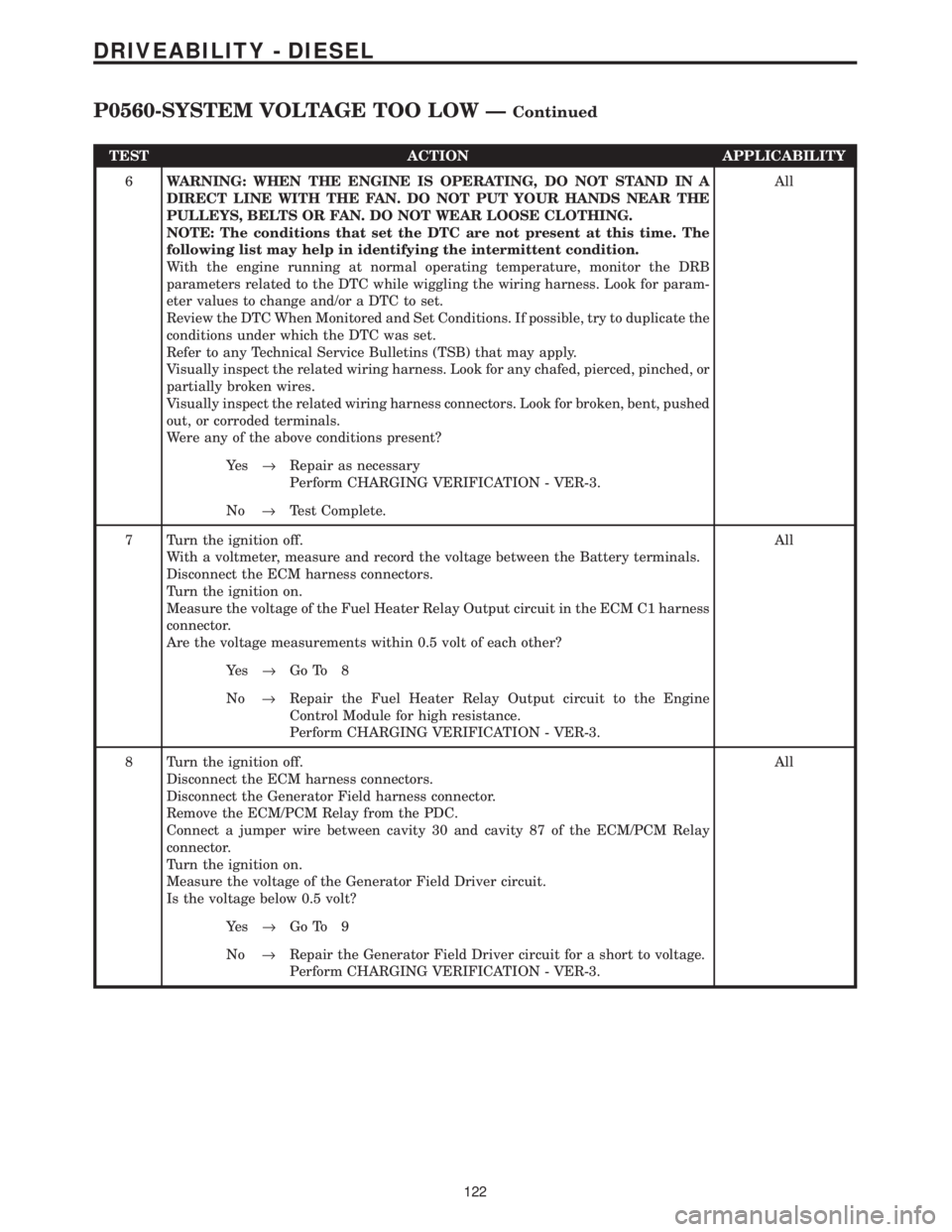
TEST ACTION APPLICABILITY
6WARNING: WHEN THE ENGINE IS OPERATING, DO NOT STAND IN A
DIRECT LINE WITH THE FAN. DO NOT PUT YOUR HANDS NEAR THE
PULLEYS, BELTS OR FAN. DO NOT WEAR LOOSE CLOTHING.
NOTE: The conditions that set the DTC are not present at this time. The
following list may help in identifying the intermittent condition.
With the engine running at normal operating temperature, monitor the DRB
parameters related to the DTC while wiggling the wiring harness. Look for param-
eter values to change and/or a DTC to set.
Review the DTC When Monitored and Set Conditions. If possible, try to duplicate the
conditions under which the DTC was set.
Refer to any Technical Service Bulletins (TSB) that may apply.
Visually inspect the related wiring harness. Look for any chafed, pierced, pinched, or
partially broken wires.
Visually inspect the related wiring harness connectors. Look for broken, bent, pushed
out, or corroded terminals.
Were any of the above conditions present?All
Ye s®Repair as necessary
Perform CHARGING VERIFICATION - VER-3.
No®Test Complete.
7 Turn the ignition off.
With a voltmeter, measure and record the voltage between the Battery terminals.
Disconnect the ECM harness connectors.
Turn the ignition on.
Measure the voltage of the Fuel Heater Relay Output circuit in the ECM C1 harness
connector.
Are the voltage measurements within 0.5 volt of each other?All
Ye s®Go To 8
No®Repair the Fuel Heater Relay Output circuit to the Engine
Control Module for high resistance.
Perform CHARGING VERIFICATION - VER-3.
8 Turn the ignition off.
Disconnect the ECM harness connectors.
Disconnect the Generator Field harness connector.
Remove the ECM/PCM Relay from the PDC.
Connect a jumper wire between cavity 30 and cavity 87 of the ECM/PCM Relay
connector.
Turn the ignition on.
Measure the voltage of the Generator Field Driver circuit.
Is the voltage below 0.5 volt?All
Ye s®Go To 9
No®Repair the Generator Field Driver circuit for a short to voltage.
Perform CHARGING VERIFICATION - VER-3.
122
DRIVEABILITY - DIESEL
P0560-SYSTEM VOLTAGE TOO LOW ÐContinued
Page 1343 of 4284

Symptom:
P0615-STARTER RELAY CIRCUIT SHORT CIRCUIT
When Monitored and Set Condition:
P0615-STARTER RELAY CIRCUIT SHORT CIRCUIT
When Monitored: With the ignition on.
Set Condition: The ECM detects a short to voltage on the Starter Relay Control circuit.
POSSIBLE CAUSES
INTERMITTENT CONDITION
SUBSTITUTE ECM/PCM RELAY
STARTER RELAY OUTPUT CIRCUIT SHORTED TO VOLTAGE
ENGINE CONTROL MODULE
TEST ACTION APPLICABILITY
1 Turn the ignition on.
With the DRB, erase ECM DTCs.
Attempt to start the engine several times, pausing for at least 10 seconds between
each cycle.
Turn the ignition on.
With the DRB, read ECM DTCs.
Did this DTC reset?All
Ye s®Go To 2
No®Go To 4
2 Turn the ignition off.
Install a substitute relay in place of the Starter Relay.
Attempt to start the engine several times, pausing for at least 10 seconds between
each cycle.
Turn the ignition on.
With the DRB, read ECM DTCs.
Did this DTC reset?All
Ye s®Go To 3
No®Replace the Starter Relay.
Perform ROAD TEST VERIFICATION - VER-2.
3 Turn the ignition off.
Remove the Starter Relay from the IPM.
Turn the ignition on.
Measure the voltage of the Starter Relay Output circuit.
Is the voltage below 1.0 volt?All
Ye s®Replace and program the Engine Control Module in accordance
with the Service Information.
Perform ROAD TEST VERIFICATION - VER-2.
No®Repair the Starter Relay Output circuit for a short to voltage.
Perform ROAD TEST VERIFICATION - VER-2.
124
DRIVEABILITY - DIESEL
Page 1344 of 4284
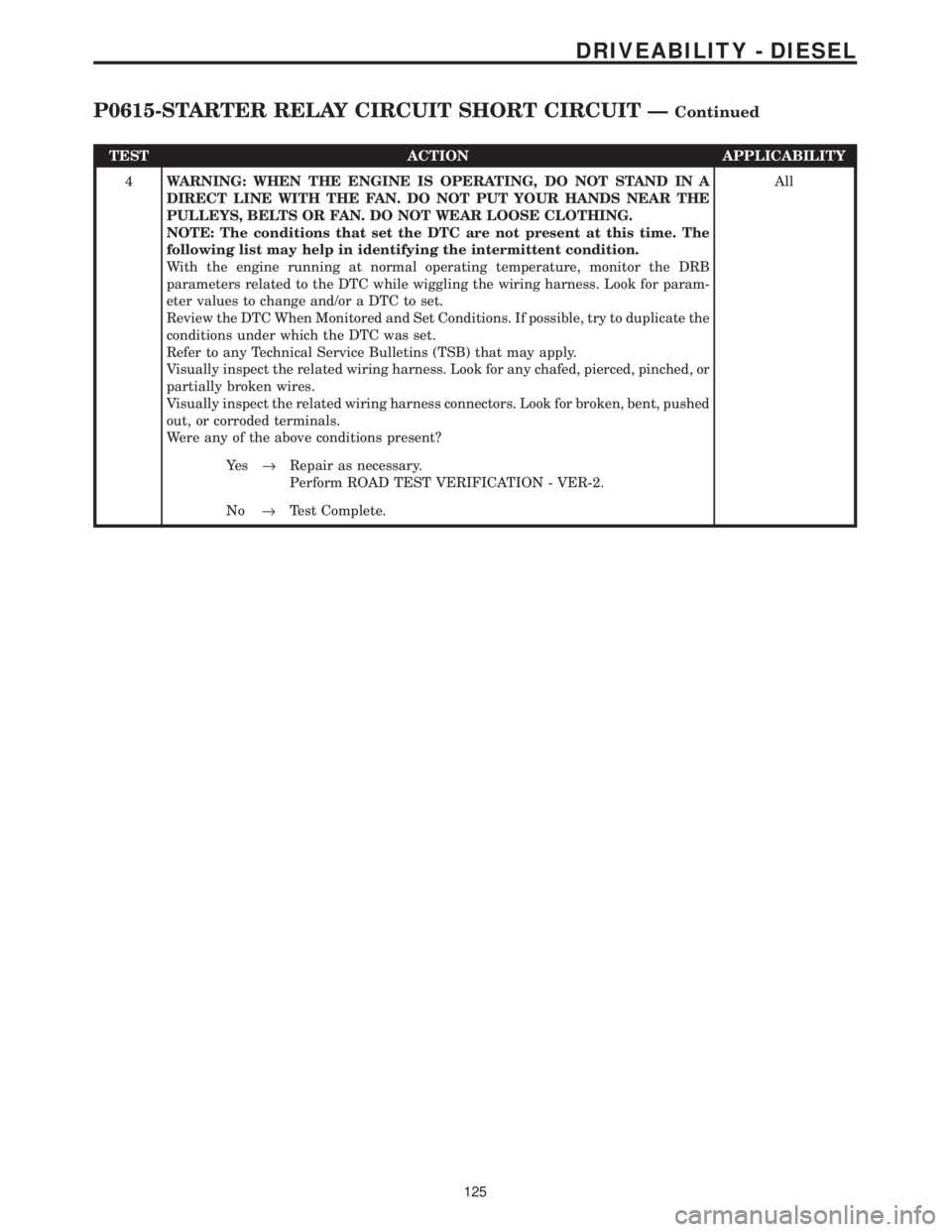
TEST ACTION APPLICABILITY
4WARNING: WHEN THE ENGINE IS OPERATING, DO NOT STAND IN A
DIRECT LINE WITH THE FAN. DO NOT PUT YOUR HANDS NEAR THE
PULLEYS, BELTS OR FAN. DO NOT WEAR LOOSE CLOTHING.
NOTE: The conditions that set the DTC are not present at this time. The
following list may help in identifying the intermittent condition.
With the engine running at normal operating temperature, monitor the DRB
parameters related to the DTC while wiggling the wiring harness. Look for param-
eter values to change and/or a DTC to set.
Review the DTC When Monitored and Set Conditions. If possible, try to duplicate the
conditions under which the DTC was set.
Refer to any Technical Service Bulletins (TSB) that may apply.
Visually inspect the related wiring harness. Look for any chafed, pierced, pinched, or
partially broken wires.
Visually inspect the related wiring harness connectors. Look for broken, bent, pushed
out, or corroded terminals.
Were any of the above conditions present?All
Ye s®Repair as necessary.
Perform ROAD TEST VERIFICATION - VER-2.
No®Test Complete.
125
DRIVEABILITY - DIESEL
P0615-STARTER RELAY CIRCUIT SHORT CIRCUIT ÐContinued
Page 1346 of 4284
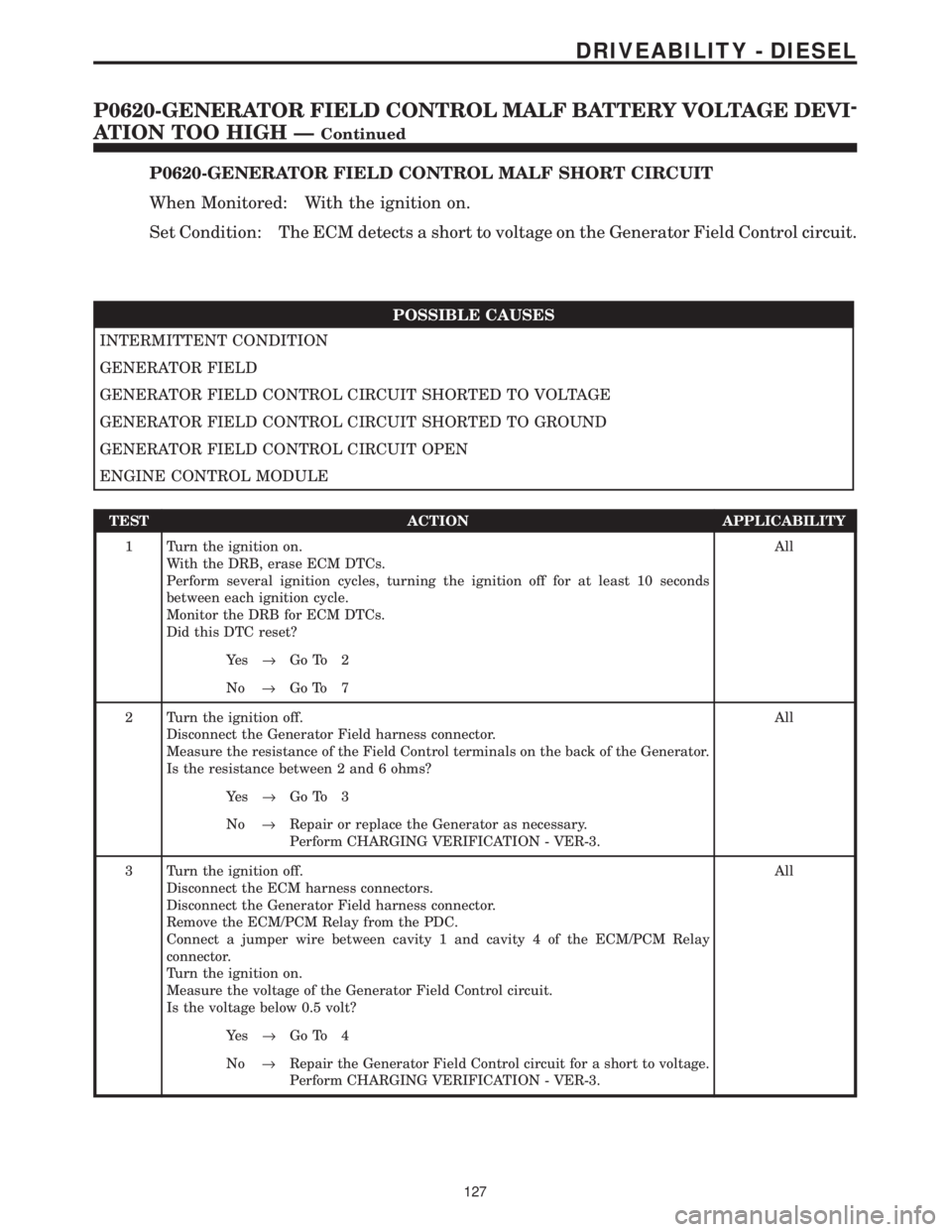
P0620-GENERATOR FIELD CONTROL MALF SHORT CIRCUIT
When Monitored: With the ignition on.
Set Condition: The ECM detects a short to voltage on the Generator Field Control circuit.
POSSIBLE CAUSES
INTERMITTENT CONDITION
GENERATOR FIELD
GENERATOR FIELD CONTROL CIRCUIT SHORTED TO VOLTAGE
GENERATOR FIELD CONTROL CIRCUIT SHORTED TO GROUND
GENERATOR FIELD CONTROL CIRCUIT OPEN
ENGINE CONTROL MODULE
TEST ACTION APPLICABILITY
1 Turn the ignition on.
With the DRB, erase ECM DTCs.
Perform several ignition cycles, turning the ignition off for at least 10 seconds
between each ignition cycle.
Monitor the DRB for ECM DTCs.
Did this DTC reset?All
Ye s®Go To 2
No®Go To 7
2 Turn the ignition off.
Disconnect the Generator Field harness connector.
Measure the resistance of the Field Control terminals on the back of the Generator.
Is the resistance between 2 and 6 ohms?All
Ye s®Go To 3
No®Repair or replace the Generator as necessary.
Perform CHARGING VERIFICATION - VER-3.
3 Turn the ignition off.
Disconnect the ECM harness connectors.
Disconnect the Generator Field harness connector.
Remove the ECM/PCM Relay from the PDC.
Connect a jumper wire between cavity 1 and cavity 4 of the ECM/PCM Relay
connector.
Turn the ignition on.
Measure the voltage of the Generator Field Control circuit.
Is the voltage below 0.5 volt?All
Ye s®Go To 4
No®Repair the Generator Field Control circuit for a short to voltage.
Perform CHARGING VERIFICATION - VER-3.
127
DRIVEABILITY - DIESEL
P0620-GENERATOR FIELD CONTROL MALF BATTERY VOLTAGE DEVI-
ATION TOO HIGH Ð
Continued
Page 1347 of 4284
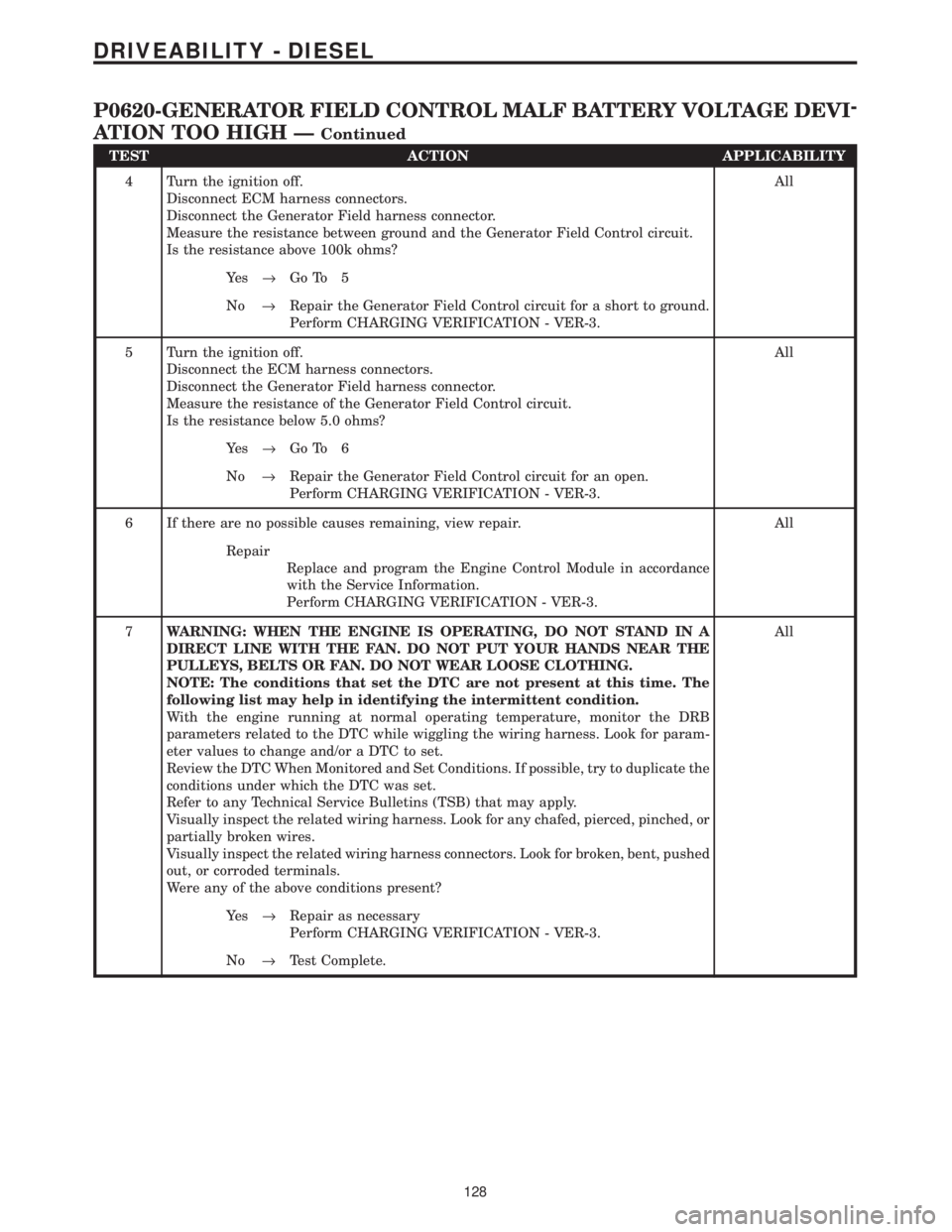
TEST ACTION APPLICABILITY
4 Turn the ignition off.
Disconnect ECM harness connectors.
Disconnect the Generator Field harness connector.
Measure the resistance between ground and the Generator Field Control circuit.
Is the resistance above 100k ohms?All
Ye s®Go To 5
No®Repair the Generator Field Control circuit for a short to ground.
Perform CHARGING VERIFICATION - VER-3.
5 Turn the ignition off.
Disconnect the ECM harness connectors.
Disconnect the Generator Field harness connector.
Measure the resistance of the Generator Field Control circuit.
Is the resistance below 5.0 ohms?All
Ye s®Go To 6
No®Repair the Generator Field Control circuit for an open.
Perform CHARGING VERIFICATION - VER-3.
6 If there are no possible causes remaining, view repair. All
Repair
Replace and program the Engine Control Module in accordance
with the Service Information.
Perform CHARGING VERIFICATION - VER-3.
7WARNING: WHEN THE ENGINE IS OPERATING, DO NOT STAND IN A
DIRECT LINE WITH THE FAN. DO NOT PUT YOUR HANDS NEAR THE
PULLEYS, BELTS OR FAN. DO NOT WEAR LOOSE CLOTHING.
NOTE: The conditions that set the DTC are not present at this time. The
following list may help in identifying the intermittent condition.
With the engine running at normal operating temperature, monitor the DRB
parameters related to the DTC while wiggling the wiring harness. Look for param-
eter values to change and/or a DTC to set.
Review the DTC When Monitored and Set Conditions. If possible, try to duplicate the
conditions under which the DTC was set.
Refer to any Technical Service Bulletins (TSB) that may apply.
Visually inspect the related wiring harness. Look for any chafed, pierced, pinched, or
partially broken wires.
Visually inspect the related wiring harness connectors. Look for broken, bent, pushed
out, or corroded terminals.
Were any of the above conditions present?All
Ye s®Repair as necessary
Perform CHARGING VERIFICATION - VER-3.
No®Test Complete.
128
DRIVEABILITY - DIESEL
P0620-GENERATOR FIELD CONTROL MALF BATTERY VOLTAGE DEVI-
ATION TOO HIGH Ð
Continued